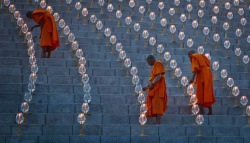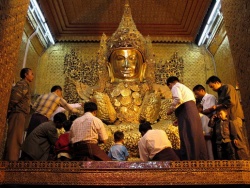A Critique of Buddhist Philosophy by the Vaishnava Acharyas
Sri Chaitanya Charitamrita Madhya-lila 9:49. text and Purport,
tarka-pradhāna bauddha-śāstra ‘nava mate’
tarkei khaṇḍila prabhu, nā pāre sthāpite
SYNONYMS
tarka-pradhāna—argumentative; bauddha-śāstra—scriptures of the Buddhist cult; nava mate—in nine basic principles; tarkei—by argument; khaṇḍila—refuted; prabhu—Śrī Caitanya Mahāprabhu; nā—not; pāre—can; sthāpite—establish.
TRANSLATION
The scriptures of the Buddhist cult are chiefly based on argument and logic, and they contain nine chief principles. Because Śrī Caitanya Mahāprabhu defeated the Buddhists in their argument, they could not establish their cult.
PURPORT by Srila A.C. Bhaktivedanta Swami Prabhupada:
Śrīla Bhaktivinoda Ṭhākura states that according to the Buddhist cult there are two ways of understanding philosophy. One is called Hīnāyāna, and the other is called Mahāyāna. Along the Buddhist path there are nine principles: (1) The creation is eternal; therefore there is no need to accept a creator. (2) This cosmic manifestation is false. (3) “I am” is the truth. (4) There is repetition of birth and death. (5) Lord Buddha is the only source of understanding the truth. (6) The principle of nirvāṇa, or annihilation, is the ultimate goal. (7) The philosophy of Buddha is the only philosophical path. (8) The Vedas are compiled by human beings. (9) Pious activities, showing mercy to others and so on are advised.
No one can attain the Absolute Truth by argument. One may be very expert in logic, and another person may be even more expert in the art of argument. Because there is so much word jugglery in logic, one can never come to the real conclusion about the Absolute Truth by argument. The followers of the Vedic principles understand this. However, it is seen here that Śrī Caitanya Mahāprabhu defeated the Buddhist philosophy by argument. Those who are preachers in ISKCON will certainly meet many people who believe in intellectual arguments. Most of these people do not believe in the authority of the Vedas. Nevertheless, they accept intellectual speculation and argument. Therefore the preachers of Kṛṣṇa consciousness should be prepared to defeat others by argument, just as Śrī Caitanya Mahāprabhu did. In this verse it is clearly said, tarkei khaṇḍila prabhu. Lord Śrī Caitanya Mahāprabhu put forward such a strong argument that the Buddhists could not counter Him to establish their cult.
Their first principle is that the creation has always existed. But if this were the case, there could be no theory of annihilation. The Buddhists maintain that annihilation, or dissolution, is the highest truth. If the creation eternally exists, there is no question of dissolution or annihilation. This argument is not very strong because by practical experience we see that material things have a beginning, a middle and an end. The ultimate aim of the Buddhist philosophy is to dissolve the body. This is proposed because the body has a beginning. Similarly, the entire cosmic manifestation is also a gigantic body, but if we accept the fact that it will always exist, there can be no question of annihilation. Therefore the attempt to annihilate everything in order to attain zero is an absurdity. By our own practical experience we have to accept the beginning of creation, and when we accept the beginning, we must accept a creator. Such a creator must possess an all-pervasive body, as pointed out in the Bhagavad-gītā (13.14):
sarvataḥ pāṇi-pādaṁ tat sarvato-’kṣi-śiro-mukham
sarvataḥ śruti-mal loke sarvam āvṛtya tiṣṭhati
“Everywhere are His hands and legs, His eyes, heads and faces, and He has ears everywhere. In this way the Supersoul exists, pervading everything.”
The Supreme Person must be present everywhere. His body existed before the creation; otherwise He could not be the creator. If the Supreme Person is a created being, there can be no question of a creator. The conclusion is that the cosmic manifestation is certainly created at a certain time, and the creator existed before the creation; therefore the creator is not a created being. The creator is Parabrahman, or the Supreme Spirit. Matter is not only subordinate to spirit but is actually created on the basis of spirit. When the spirit soul enters the womb of a mother, the body is created by material ingredients supplied by the mother. Everything is created in the material world, and consequently there must be a creator who is the Supreme Spirit and who is distinct from matter. It is confirmed in the Bhagavad-gītā that the material energy is inferior and that the spiritual energy is the living entity. Both inferior and superior energies belong to a supreme person.
The Buddhists argue that the world is false, but this is not valid. The world is temporary, but it is not false. As long as we have the body, we must suffer the pleasures and pains of the body, even though we are not the body. We may not take these pleasures and pains very seriously, but they are factual nonetheless. We cannot actually say that they are false. If the bodily pains and pleasures were false, the creation would be false also, and consequently no one would take very much interest in it. The conclusion is that the material creation is not false or imaginary, but it is temporary.
The Buddhists maintain that the principle “I am” is the ultimate truth, but this excludes the individuality of “I” and “you.” If there is no “I” and “you,” or individuality, there is no possibility of argument. The Buddhist philosophy depends on argument, but there can be no argument if one simply depends on “I am.” There must be a “you,” or another person also. The philosophy of duality—the existence of the individual soul and the Supersoul—must be there. This is confirmed in the Second Chapter of the Bhagavad-gītā (2.12), wherein the Lord says:
na tv evāhaṁ jātu nāsaṁ na tvaṁ neme janādhipāḥ
na caiva na bhaviṣyāmaḥ sarve vayam ataḥ param
“Never was there a time when I did not exist, nor you, nor all these kings; nor in the future shall any of us cease to be.”
We existed in the past in different bodies, and after the annihilation of this body we shall exist in another body. The principle of the soul is eternal, and it exists in this body or in another body. Even in this lifetime we experience existence in a child’s body, a youth’s body, a man’s body and an old body. After the annihilation of the body, we acquire another body. The Buddhist cult also accepts the philosophy of transmigration, but the Buddhists do not properly explain the next birth. There are 8,400,000 species of life, and our next birth may be in any one of them; therefore this human body is not guaranteed.
According to the Buddhists’ fifth principle, Lord Buddha is the only source for the attainment of knowledge. We cannot accept this, for Lord Buddha rejected the principles of Vedic knowledge. One must accept a principle of standard knowledge because one cannot attain the Absolute Truth simply by intellectual speculation. If everyone is an authority, or if everyone accepts his own intelligence as the ultimate criterion—as is presently fashionable—the scriptures will be interpreted in many different ways, and everyone will claim that his own philosophy is supreme. This has become a very great problem, and everyone is interpreting scripture in his own way and setting up his own basis of authority. Yata mata tata patha. Now everybody and anybody is trying to establish his own theory as the ultimate truth. The Buddhists theorize that annihilation, or nirvāṇa, is the ultimate goal. Annihilation applies to the body, but the spirit soul transmigrates from one body to another. If this were not the case, how can so many multifarious bodies come into existence? If the next birth is a fact, the next bodily form is also a fact. As soon as we accept a material body, we must accept the fact that that body will be annihilated and that we will have to accept another body. If all material bodies are doomed to annihilation, we must obtain a nonmaterial body, or a spiritual body, if we wish the next birth to be anything but false. How the spiritual body is attained is explained by Lord Kṛṣṇa in the Bhagavad-gītā (4.9):
janma karma ca me divyam evaṁ yo vetti tattvataḥ tyaktvā dehaṁ punar janma naiti mām eti so ’rjuna
“One who knows the transcendental nature of My appearance and activities does not, upon leaving the body, take his birth again in this material world, but attains My eternal abode, O Arjuna.” This is the highest perfection—to give up one’s material body and not accept another but to return home, back to Godhead. It is not that perfection means one’s existence becomes void or zero. Existence continues, but if we positively want to annihilate the material body, we have to accept a spiritual body; otherwise there can be no eternality for the soul.
We cannot accept the theory that the Buddhist philosophy is the only way, for there are so many defects in that philosophy. A perfect philosophy is one that has no defects, and that is Vedānta philosophy. No one can point out any defects in Vedānta philosophy, and therefore we can conclude that Vedānta is the supreme philosophical way of understanding the truth. According to the Buddhist cult, the Vedas are compiled by ordinary human beings. If this were the case, they would not be authoritative. From the Vedic literatures we understand that shortly after the creation Lord Brahmā was instructed in the Vedas. It is not that the Vedas were created by Brahmā, although Brahmā is the original person in the universe. If Brahmā did not create the Vedas but he is acknowledged as the first created being, wherefrom did Vedic knowledge come to Brahmā?
Obviously the Vedas did not come from an ordinary person born in this material world. According to Śrīmad-Bhāgavatam, tene brahma hṛdā ya ādi-kavaye: after the creation, the Supreme Person imparted Vedic knowledge within the heart of Brahmā. There was no person in the beginning of the creation other than Brahmā, yet he did not compile the Vedas; therefore the conclusion is that the Vedas were not compiled by any created being. Vedic knowledge was given by the Supreme Personality of Godhead, who created this material world. This is also accepted by Śaṅkarācārya, although he is not a Vaiṣṇava.
It is stated that mercy is one of the qualities of a Buddhist, but mercy is a relative thing. We show our mercy to a subordinate or to one who is suffering more than ourselves. However, if there is a superior person present, the superior person cannot be the object of our mercy. Rather, we are objects for the mercy of the superior person. Therefore showing compassion and mercy is a relative activity. It is not the Absolute Truth. Apart from this, we also must know what actual mercy is. To give a sick man something forbidden for him to eat is not mercy. Rather, it is cruelty. Unless we know what mercy really is, we may create an undesirable situation. If we wish to show real mercy, we will preach Kṛṣṇa consciousness in order to revive the lost consciousness of human beings, the living entity’s original consciousness. Since the Buddhist philosophy does not admit the existence of the spirit soul, the so-called mercy of the Buddhists is defective.
Following in the Footsteps of Saintly Persons:
In the Skanda Purāṇa it is advised that a devotee follow the past ācāryas and saintly persons, because by such following one can achieve the desired results, with no chance of lamenting or being baffled in his progress.
The scripture known as Brahma-yāmala states as follows: “If someone wants to pose himself as a great devotee without following the authorities of the revealed scriptures, then his activities will never help him to make progress in devotional service. Instead, he will simply create disturbances for the sincere students of devotional service.” Those who do not strictly follow the principles of revealed scriptures are generally called sahajiyās—those who have imagined everything to be cheap, who have their own concocted ideas, and who do not follow the scriptural injunctions. Such persons are simply creating disturbances in the discharge of devotional service.
In this connection, an objection may be raised by those who are not in devotional service and who do not care for the revealed scriptures. An example of this is seen in Buddhist philosophy. Lord Buddha appeared in the family of a high-grade kṣatriya king, but his philosophy was not in accord with the Vedic conclusions and therefore was rejected. Under the patronage of a Hindu king, Mahārāja Aśoka, the Buddhist religion was spread all over India and the adjoining countries. However, after the appearance of the great stalwart teacher Śaṅkarācārya, this Buddhism was driven out beyond the borders of India.
The Buddhists or other religionists who do not care for revealed scriptures sometimes say that there are many devotees of Lord Buddha who show devotional service to Lord Buddha, and who therefore should be considered devotees. In answer to this argument, Rüpa Gosvāmī says that the followers of Buddha cannot be accepted as devotees. Although Lord Buddha is accepted as an incarnation of Kṛṣṇa, the followers of such incarnations are not very advanced in their knowledge of the Vedas. To study the Vedas means to come to the conclusion of the supremacy of the Personality of Godhead. Therefore any religious principle which denies the supremacy of the Personality of Godhead is not accepted and is called atheism. Atheism means defying the authority of the Vedas and decrying the great ācāryas who teach Vedic scriptures for the benefit of the people in general.
Lord Buddha is accepted as an incarnation of Kṛṣṇa in the Śrīmad-Bhāgavatam, but in the same Śrīmad-Bhāgavatam it is stated that Lord Buddha appeared in order to bewilder the atheistic class of men. Therefore his philosophy is meant for bewildering the atheists and should not be accepted. If someone asks, “Why should Kṛṣṇa propagate atheistic principles?” the answer is that it was the desire of the Supreme Personality of Godhead to end the violence which was then being committed in the name of the Vedas. The so-called religionists were falsely using the Vedas to justify such violent acts as meat-eating, and Lord Buddha came to lead the fallen people away from such a false interpretation of the Vedas. Also, for the atheists Lord Buddha preached atheism so that they would follow him and thus be tricked into devotional service to Lord Buddha, or Kṛṣṇa.
(Srila A.C. Bhaktivedanta Swami Prabhupada. Nectar of Devotion chapter 7. Following in the Footsteps of Saintly Persons.)






